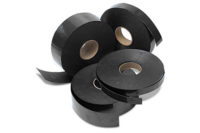
All professional finishing contractors have an opinion about what style of drywall tools works best for them. Overall, most tapers and finishers agree that hand tools are best for close-quarter finish work, such as corner beads or tray ceilings, while automatic tools are ideal for maximizing production and yield a more consistent finish.
A drywall finisher’s skill and proficiency have a substantial impact on project timing, job scheduling, resource management, and most of all, labor cost. With union positions earning between $40 and $70 per hour, the typical four-man crew costs between $160 and $280 per hour. Increase the crew’s productivity by even a little, and the return on investment can be substantial, which is why a growing number of contractors are seriously considering automatic tools.
The numbers are impressive. How much more board feet will a worker finish each day using automatic taping and finishing tools? Our research says between 30 and 50 percent.
THE LURE OF AUTOMATION
Make no mistake: A skilled drywall finisher using hand methods produces incredible work. Combine that skill set with automatic taping and finishing tools, however, and the same finisher will experience a dramatic increase in output-while maintaining a consistent finish quality.
Most contractors agree that a veteran drywall finisher has the “touch,” that special ability to work with tools, tape and compound to transform gypsum wall panels into a monolithic surface that is ready for paint. But let this same skilled drywall finisher combine the finesse of a hand finisher with the speed and efficiency of automatic tools, and the result is a near-flawless product that is produced in less time. Most finishers use automatic tools to knock out 95 percent of the time-consuming basics, so that they can spend more time focusing their craft on the fine details of a job.
The time savings lies in the ability of the tools to precisely match the rate of compound and tape flow based on the speed of the contractor. Further, the tools also control the position of compound over the joint, laying it out in exactly the right width and with the proper “crown” down the middle. This can be a tremendous productivity gain: If the automatic tool is correctly set, seams will require very little finish-sanding.
Automatic tools users also spend less time on stilts/scaffolding, because unlike hand finishers, they are perfecting a process (e.g., final wipe down) already completed safely from the ground.

Javier
Rodriguez, holding the automatic taping tool, has been taping and finishing
with RG Construction for 12 years. On stilts, Gustavo Alvarez Sr. has been
with the company for 31 years. RG Construction serves greater Chicago.
Some finishers resist the technology because they mistakenly fear that automatic tools will replace the need for skilled labor. First, whether a contractor is using manual or automatic taping tools, there is a significant amount of skill and finesse required to yield a quality job. Second, by helping the tradesman complete the job more quickly, automatic taping and finishing tools boost productivity and yield a consistent high-quality finish, helping contractors finish more jobs in a given time frame and generating more profit.
Other finishers question their ability to translate a process they have perfected by hand into a new set of tools. Not surprisingly, experience has shown that the best hand finishers also become the best automatic taping and finishing tool users.

Dave
Scobee (not pictured) was the job site foreman for this project in metro
Chicago and mentioned that RG Construction has been using Ames-brand Tools
“ever since he could remember.” A 10-year veteran with the
company, he says that there is nothing comparable to the ease and convenience
of the tool rental process; where they can simply bring in the used tools and
immediately replace them with fresh tools, so they can get right back to work.
In addition to the productivity gains offered by automatic taping and finishing tools, an often overlooked means of greater efficiencies-and profits-can be found in the maintenance of the tools themselves.
The gold standard for any finisher is a clean, fully calibrated tool. Ordering supplies, performing tool maintenance and other secondary tasks all detract from active finishing and profitability.
Assume for moment that each taper spends just 30 minutes a day adjusting or repairing his tools, and you can quickly see the hundreds of hours of productivity stolen by a defective or broken tool. Moreover, a jerry-rigged tool results in substandard quality, time-consuming repetitions and lost productivity.
Given this sobering economic reality, how does a contractor decide whether to own or rent his automatic tools? What productivity measures does he use to guide his choice?
Well, that depends. Owning a set of taping tools is ideal for a contractor who properly maintains his investment through routine cleaning, lubricating and replacement of standard wear parts. But for his equally conscientious counterpart who must share tools across a job site, a rental arrangement assures that no matter who last ran a particular tool, it can be changed out, at no cost, for a clean and fully-calibrated tool.
Unfortunately, the real productivity thief is found in between these two scenarios. The contractor who purchases tools-with the best intentions-but, due to work load or compressed schedules, cannot properly maintain them is forced to make due. He must compensate for a poorly performing or broken tool by working additional hours or overstaffing a job.
PHASE UP
Since 1973, Phase 2 Co. has been serving Colorado as a subcontractor specializing in drywall, light gauge steel framing, insulation, stucco, acoustical ceilings, wall coverings and painting. Based in Ft. Collins, Colo., the company services the Colorado Front Range and southern Wyoming.Specializing in commercial and industrial projects, the large contractor currently employees approximately 100 workers. The second-generation business was founded by Danial Larsen; now, Alison Larsen is president and Kirk Larsen serves as the company’s vice president. Although the company reports that the market is still bad, Phase 2 does have 25 projects going on right now and anticipates a full schedule this year. At its height, Phase 2 had as many as 500 workers several years back. As business builds, the company is trying to bring back as many of those workers as possible.
Kirk Larsen says a specialty service Phase 2 provides is the combo of drywall-acoustical ceilings-painting, a benefit for customers who don’t have to bid three different subcontractors.
Working closely with Gypsum Products of Colorado, Phase 2 uses mostly Ames taping tools.
“The guys like the tools and the service,” says Kirk Larsen. “We rent everything from Gypsum Products, who allow us to return the tools at any of its locations (we use both Denver and Ft. Collins). We usually have the same kit: the bazooka, corner handles, mud boxes, and different finishing tools that Ames provides.”
A trick the company uses to minimize the daily clean-up of the taping tools is to leave them in “water coffins,” boxes made by Phase 2 that keep the tools wet.



Report Abusive Comment